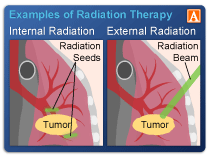
Recently Diagnosed or Relapsed? Stop Looking For a Miracle Cure, and Use Evidence-Based Therapies To Enhance Your Treatment and Prolong Your Remission
Multiple Myeloma an incurable disease, but I have spent the last 25 years in remission using a blend of conventional oncology and evidence-based nutrition, supplementation, and lifestyle therapies from peer-reviewed studies that your oncologist probably hasn't told you about.
Click the orange button to the right to learn more about what you can start doing today.
- You are here:
- Home »
- Blog »
- Multiple Myeloma »
- Can Radiation/Imaging Cause Myeloma?
Can Radiation/Imaging Cause Myeloma?

Can radiation from imaging cause myeloma? This question was posed in a Facebook group that I belong to. Not being sure enough of the answer to post a reply, I decided to research the issue and write a blog post about what I found.
A couple of issues before I begin.
First and foremost, I am a myeloma survivor who has undergone a fair amount of radiation for both my treatment as well as for various imaging studies including:
- x-rays (many over the years)
- CT scans (several)
- PET-scans (one)
- Local radiation therapy for a lytic lesion (44 grays I think)
Radiation therapy caused several long-term side effects including:
My point is that I have a love-hate relationship with radiation. Radiation helped me manage my myeloma however, after aggressive conventional therapies (both chemo and radiation) my oncologist told me that “nothing more could be done.” And my answer to the question is reflects this conflict.
The relationship between medical imaging and the risk of developing multiple myeloma is a subject of scientific research. Multiple myeloma is a type of cancer that affects plasma cells in the bone marrow.
Some studies have suggested a potential link between repeated exposure to ionizing radiation, such as that used in certain types of medical imaging (like X-rays and CT scans), and an increased risk of developing multiple myeloma. However, the evidence for this association is not entirely conclusive and the risk, if any, appears to be relatively small.
Long story short, radiation, all forms of radiation, increase the RISK of myeloma. I won’t go so far as to say “radiation causes myeloma. “
Radiation in any form increases your risk of cancer. Especially blood cancers like multiple myeloma. Notice I said “risk.”
If you have concerns about the potential risks of medical imaging and its association with multiple myeloma, it is best to discuss them with your healthcare provider. They can provide you with personalized information and recommendations based on your specific medical history and circumstances. They can also help weigh the benefits of the imaging procedure against any potential risks.
Have you been diagnosed with multiple myeloma? What symptoms? What stage are you? Yes, work to moderate the amount of radiation you are exposed to.
Let me know, thanks.
David.PeopleBeatingCancer@gmail.com
David Emerson
- MM Survivor
- MM Cancer Coach
- Director PeopleBeatingCancer
What are the risk factors for multiple myeloma?
“There are several risk factors linked to multiple myeloma, including age, genetics, obesity, radiation exposure, and other conditions…
In rare cases, a person may be at higher riskTrusted Source of developing multiple myeloma if they have been exposed to X-rays or other kinds of ionizing radiation.
The Center for Environmental Health Studies reported that people who worked at nuclear facilities and who were regularly exposed to ionizing radiation experienced higher rates of death due to multiple myeloma than the general population.
One study found that workers at a uranium enrichment site who breathed in or swallowed radioactive particles had a 4%Trusted Source higher chance of dying of multiple myeloma than workers exposed in other ways. It found no increased chance of multiple myeloma in workers who were only exposed to radiation outside the body…”
What are the risk factors for multiple myeloma?
“A risk factor is anything that increases a person’s chance of developing cancer. Although risk factors often influence the development of cancer, most do not directly cause cancer. Some people with several risk factors never develop cancer, while others with no known risk factors do. But knowing your risk factors and talking about them with your doctor may help you make more informed lifestyle and health care choices…
- Exposure to radiation or chemicals. People who have been exposed to radiation or to asbestos, benzene, pesticides, and other chemicals used in rubber manufacturing may be at higher risk for developing myeloma. People often exposed to wood products, such as carpenters, furniture makers, and paper makers, are also at higher risk. There is also a high incidence of myeloma among professional firefighters and those exposed to herbicides, including Agent Orange…
Exposure to Radiation and the Risk for Myeloma
“Scientists don’t yet understand the exact causes of multiple myeloma. However, they have identified several risk factors that can increase a person’s chances of developing this condition. Radiation exposure is one of these possible risk factors…”
Radiation and Myeloma
Multiple myeloma, like other forms of cancer, can develop when gene changes occur within cells. In the case of myeloma, these changes occur within plasma cells. A plasma cell is a type of white blood cell that produces immune system proteins known as antibodies that help kill germs.
When plasma cell genes mutate due to high levels of radiation or other causes, they may start to grow and divide too quickly or evade death. This leads to tumors in the bone marrow, the soft tissue found within certain bones…
Medical Radiation
Radiation is used during the diagnosis and treatment of several different types of health conditions. Many imaging tests used to get a closer look at internal organs and tissues use small amounts of radiation. These may include:
- X-rays
- Bone scans
- Computed tomography (CT) scans
- Positron emission tomography (PET) scans
Radiation therapy is a common cancer treatment. Some people may undergo sessions in which a machine aims beams of radiation at a tumor. Alternatively, some cancers may be treated with internal radiation therapy, which entails delivering radioactive material into the body, near cancer cells. Radiation therapy may slightly increase one’s risk of developing multiple myeloma or another cancer. However, it can often be very effective at treating a current cancer…”


